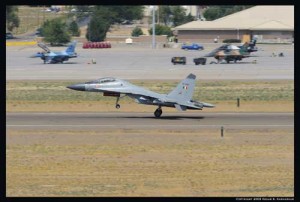Second, increasing BVR precision strike capabilities also imply that even well-defended military targets can be located and attacked with greater precision deep inside hostile territory. One can easily identify enemy reserves as a potential priority target system to influence the land battle. Perhaps more important, especially in more ambiguous political conditions (like we found ourselves after the terrorist attack on parliament in December 2001) the challenge would be how to influence the behaviour of the sponsors of terrorism. In other words, punitive air strikes would be necessary to achieve this, which must also ensure that we retain the initiative in any escalation process. This requires capabilities to dominate in the air, and to be able to undertake precision strikes deep inside hostile territory in a manner where any response to the strikes would fail to lead to any advantage to the adversary.
The role and impact of junior leadership in modern warfare has increased enormously in modern warfare. And it is here that we seem to function with major deficit for years and years. This sounds surprising in a country of 1.1 billion.
Strategic reach, therefore, must serve the purpose of an extended range for precision strike. And to maximise the advantages, it must deny any advantage of strategic depth to the other side while exploiting one’s own strategic depth. We have not looked at the factor strategic depth in the past due to a number of reasons. Curiously it has been Pakistan that has expanded its strategic depth by occupying a large part of J&K to its east, and has been trying hard to expand it westward by trying to controlAfghanistan, first through the Mujahideen and later through the Taliban. China has done the same by occupying Tibet and parts of India in Ladakh, while claiming the whole state of Arunachal Pradesh in our northeast.
There are many steps that the IAF can take to rectify this situation now that it is extending its strategic reach. Fundamentally it has to re-orient its strategic posture by altering its deployment spread across the heartland of the country to shift the bulk of its operational bases out of reach of the adversary’s air power, and retaining the current bases as launch/recovery of support missions in case of war.
One aspect not accorded adequate attention is that air forces – and the IAF can be no different – have the ability to exploit the strategic depth (or rather, the strategic height) in the vertical dimension. In fact air forces operate to battle in that domain. That is what the USAF refers to as the “high battle” which extends all the way to space. Regardless of the contentions on the ownership issues, the reality is that IAF needs to build and exploit space assets and capabilities in space if it has to take full advantage of its inherent attributes and modern technology to function as a modern air force. This requires the full support of the other services if they are to be effectively supported from the air, whether directly or indirectly. The example of the US after years of experimentation is of great relevance in this regard. It is indeed surprising that while the nation depends on the military forces and the Air Force for its defence, the Armed Forces seem to be hesitant to build trust among each other in violation of the central principle of the fighting forces that relies on trust in each other as the critical element of success in war and peace.
Human Capital for the Future
Any organisation is only as good as its people; and military forces are even more sensitive to their manpower since they are dealing with matters of survival, not only of their own but chiefly of the nation itself. We pay a lot of attention to the quality of manpower and their training and skills. But we seem to have ignored the issues of sufficient numbers and seem to be perennially short of manpower, especially at the junior leadership levels. In spite of parliamentary committees emphasising over the past quarter century the need to make up the huge deficiencies in the officer cadre of the Indian Army, we seem to be functioning with a nearly 23% shortage at the junior (and cutting edge) of our army officer leadership.
 Now we find the defence minister confirming in the parliament last July that IAF is short of 683 pilots. This would amount to as much as 24% shortages. Since the senior ranks get filled up by promotions, obviously such shortages are in the lower ranks which provide both the combat component as well as the battle leadership in any air force. It may be recalled that during World War II Germany (and Japan) started to lose the war once the shortage of pilots started to impact combat capabilities. The role and impact of junior leadership in modern warfare has increased enormously in modern warfare. And it is here that we seem to function with major deficit for years and years. This sounds surprising in a country of 1.1 billion. But the reality is that this is a failure of planning.
Now we find the defence minister confirming in the parliament last July that IAF is short of 683 pilots. This would amount to as much as 24% shortages. Since the senior ranks get filled up by promotions, obviously such shortages are in the lower ranks which provide both the combat component as well as the battle leadership in any air force. It may be recalled that during World War II Germany (and Japan) started to lose the war once the shortage of pilots started to impact combat capabilities. The role and impact of junior leadership in modern warfare has increased enormously in modern warfare. And it is here that we seem to function with major deficit for years and years. This sounds surprising in a country of 1.1 billion. But the reality is that this is a failure of planning.




